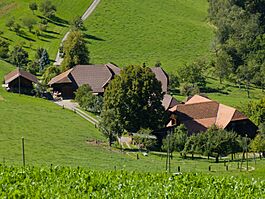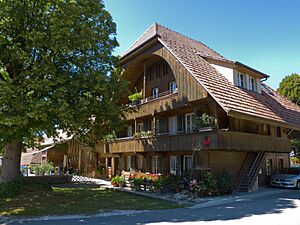Oberbalm facts for kids
Quick facts for kids
Oberbalm
|
||
|---|---|---|
 |
||
|
||
| Country | Switzerland | |
| Canton | Bern | |
| District | Bern-Mittelland | |
| Area | ||
| • Total | 12.39 km2 (4.78 sq mi) | |
| Elevation | 821 m (2,694 ft) | |
| Population
(Dec 2020 )
|
||
| • Total | 866 | |
| • Density | 69.90/km2 (181.03/sq mi) | |
| Postal code |
3096
|
|
| Localities | Borisried | |
| Surrounded by | Köniz, Niedermuhlern, Rüeggisberg, Wahlern, Wald | |
Oberbalm is a small town, also called a municipality, in Switzerland. It's located in the Bern-Mittelland administrative district, which is part of the canton of Bern. Oberbalm is known for its beautiful countryside and its long history.
Contents
A Look at Oberbalm's Past
Oberbalm was first mentioned in official records in the year 1228. Back then, it was called Balmes. The town grew up around a special pilgrimage site from the medieval times. A pilgrimage is a journey to a holy place.
How Oberbalm Became Part of Bern
The area was once owned by the counts of Laupen-Sternberg. They lived in a castle near Oberbalm, above the Scherliau river. In 1388, the city of Bern gained control over the region. This meant Oberbalm became part of Bern's court of Sternberg. It stayed this way until 1803. Later, in 1831, Oberbalm became part of the Bern district.
The Story of St. Sulpitius Church
The counts of Laupen-Sternberg also helped start the village church, called St. Sulpitius. It was built before 1215 and first mentioned in 1228. You can still see parts of the original Romanesque building in the main part of the church.
The church's walls were painted with murals in 1480. The church tower and the choir (the part of the church where the choir sings) were built between 1517 and 1527. People used to make pilgrimages to Oberbalm to see the relics of St. Sulpitius. These visits were so popular that in 1462, the Bern City Council decided to move the relics to the new Cathedral of Bern.
During the Protestant Reformation in 1528, the village changed its religion. The church then came under the control of the city of Bern.
Oberbalm's Growth Over Time
For a long time, the main village of Oberbalm was quite small. It was only a little bigger than the surrounding small communities, called hamlets. In 1838, the village had only 19 houses. The hamlets around it had 114 houses in total.
Even though it was small, the village was important. It had the church, a school, a blacksmith, and a tavern. These were all central places for the people living nearby. In the 20th century, Oberbalm started to grow. More people moved there, especially those who worked in Bern and wanted to live in a quieter place.
Oberbalm's Natural Surroundings
Oberbalm covers an area of about 12.40 square kilometers (about 4.79 square miles). A large part of this land, about 74%, is used for farming. Forests cover about 20.8% of the area. The rest of the land, about 4.6%, has buildings or roads. A tiny part, 0.2%, is made up of rivers or lakes.
Most of the built-up areas are houses and other buildings. Roads and other transport paths make up a smaller part. In the forests, most of the land is covered with thick trees. Some areas have orchards or small groups of trees. For farming, about 21.2% of the land is used for growing crops. Over half of the farming land, 50.5%, is used for pastures where animals graze. A small part, 2.3%, is for orchards or vineyards. All the water in Oberbalm is flowing water, like streams.
The town is located in a hilly, rural area. It sits between two streams, the Schwarzwasser and Scherlibach. Oberbalm includes the main village, many scattered hamlets, and individual farm houses.
Oberbalm's Coat of Arms
The blazon (a special description) of Oberbalm's coat of arms is: Per fess vert and Argent a Holly branch counterchanged. This means it has two horizontal sections. The top section is green (vert) and the bottom is silver (Argent). There is a holly branch that changes color where the two sections meet.
People of Oberbalm
Oberbalm has a population of about 865 people (as of 2022). A small part of the population, about 4.3%, are people from other countries. Over the last ten years, the population has grown slightly.
Most people in Oberbalm speak German as their first language. This is about 98.9% of the population. A very small number of people speak French, English, or Italian.
In 2008, the population was almost equally split between men and women. About 50.1% were men and 49.9% were women. Most of the people living in Oberbalm were born either in the town itself or in the same canton of Bern.
Young people (ages 0–19) make up about 20.6% of the population. Adults (ages 20–64) are the largest group, at 62.5%. Seniors (over 64 years old) make up 16.9% of the population.
Many people in Oberbalm are married. In 2000, about 390 people were married. There were also people who were single, widowed, or divorced.
The chart below shows how Oberbalm's population has changed over many years:

Important Historic Buildings
Oberbalm has several buildings that are considered very important to Swiss history. These are listed as heritage sites of national significance. They include:
- The farm house at Stöckli 203
- The granaries (buildings for storing grain) at Horbermatt 114
- The granary at Oberbalmstrasse 209 A
Fun Places to Visit
The St. Sulpitius Church is a famous sight in Oberbalm. It has beautiful old paintings called frescoes from 1470. People still visit Oberbalm as a place of pilgrimage.
Every summer, a fun outdoor rock festival called "Outdoor Elch" is held on top of Balmberg Hill.
Oberbalm's Economy and Jobs
In 2011, Oberbalm had a very low unemployment rate, meaning most people who wanted jobs had them. In 2008, about 278 people worked in the town.
Types of Jobs in Oberbalm
Jobs are often grouped into three main types:
- Primary sector: This includes jobs that get raw materials from nature. In Oberbalm, most of these jobs are in farming.
- Secondary sector: These jobs involve making things. In Oberbalm, this includes manufacturing and construction (building things).
- Tertiary sector: These jobs provide services to people. In Oberbalm, this includes things like sales, working in hotels or restaurants, and education.
Many people who live in Oberbalm travel to other towns for work. In 2000, about 298 people left Oberbalm to work elsewhere, while only 27 people came into Oberbalm for work. About 17.9% of workers used public transportation to get to their jobs, and 43.5% used a private car.
Religion in Oberbalm
Based on a census from 2000, most people in Oberbalm belong to the Swiss Reformed Church, which is a Protestant church. This was about 82.9% of the population. A smaller number, about 4.3%, were Roman Catholic. There were also people who belonged to other Christian churches, or no church at all.
Learning and Education
In Oberbalm, many adults have completed higher education. About 37.6% of the population finished non-mandatory upper secondary education. About 10.3% went on to get a university degree or similar higher education.
The School System in Bern
The school system in the Canton of Bern works like this:
- One year of non-required Kindergarten.
- Six years of Primary school.
- Three years of required lower Secondary school. In this stage, students are grouped based on their abilities.
After lower Secondary school, students can choose to continue their education or start an apprenticeship (learning a trade on the job).
During the 2009–2010 school year, 75 students attended classes in Oberbalm. There was one kindergarten class with 14 students. The town also had three primary classes with 61 students. A small number of students in both kindergarten and primary school were not Swiss citizens or had a different first language.
In 2000, only one student from another town came to school in Oberbalm. However, 37 students who lived in Oberbalm went to schools outside the town.
See also
 In Spanish: Oberbalm para niños
In Spanish: Oberbalm para niños








